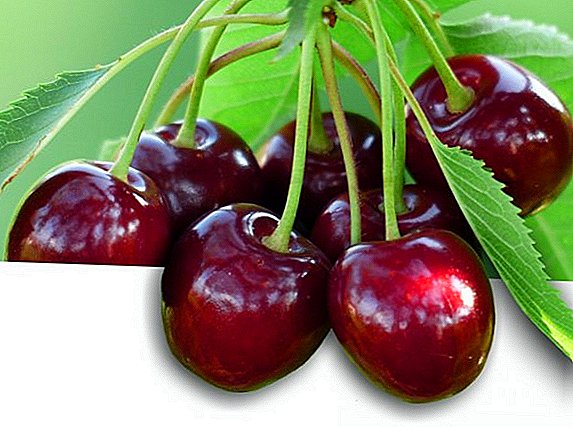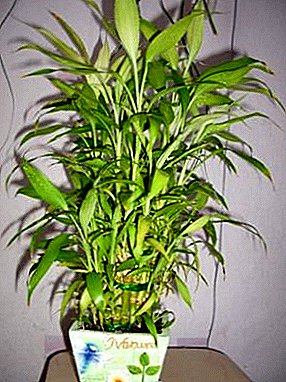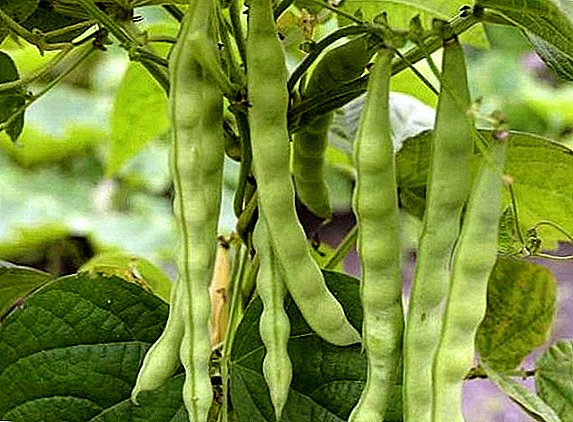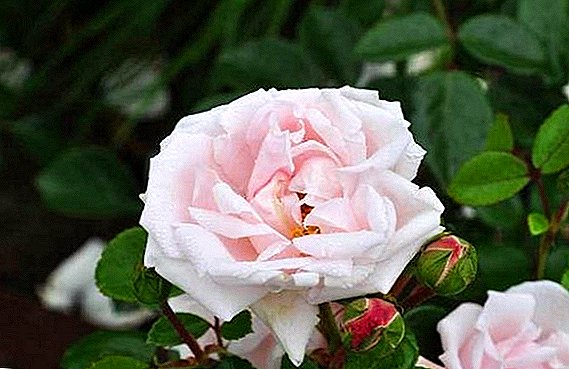 Non-capricious and trouble-free Climbing Rose "New Dawn" is a large-flowered plant. It is incredibly popular not only in Europe, but also in other countries of the world. We will tell in more detail what this flower represents, and also provide a description of how to grow it in your own plot.
Non-capricious and trouble-free Climbing Rose "New Dawn" is a large-flowered plant. It is incredibly popular not only in Europe, but also in other countries of the world. We will tell in more detail what this flower represents, and also provide a description of how to grow it in your own plot.
Breeding history
This garden flower is outstanding in all directions. The first patent for its cultivation was obtained in the United States. "New Dawn" has become a re-flowering variety, which is derived from the very hardy variety of roses Dr. W. Van Fleet.
It is characterized by the same endurance and can grow in almost any territory. The originator of the variety of roses "New Dawn" was the company "Somerset Rose Nursery".
The plant was bred in the 30s of the last century, but it does not lose its relevance among rose trees to this day. These roses grow remarkably, give out many flowers and tolerate frost quite well.
Did you know? The quality characteristics of roses could not go unnoticed. Since 1997, this plant has occupied a separate place of the “most beloved rose in the world” in the Hall of Fame of the World Federation of Rose Rose Societies (WFRS).

Photo and description
Rose "New Dawn" is one of the vigorous varieties of rose leafy roses that form long shoots during growth. Adult bushes are great for decorating vertical surfaces, as they are very wide.
Therefore, this rose is often used to create hedges or design walls. The leaves are small, smooth and have a light green color, which gradually darkens.
The flowers have a calm and even noble color. They are extremely fragrant, cup-shaped, light-filled, can fade a little under the scorching sun and change the shade from light pink to cream.
The diameter of one open flower can reach more than 6 cm. There are quite a few petals in one flower, about 25 of them, there are both convex and concave ones. Inflorescence racemose type, 5 flowers each. The flowering period begins in summer and lasts until the last weeks of autumn.
You will probably be interested to learn also about the bush and ground cover roses.It is noteworthy that flowers are able to tolerate various natural phenomena. They do not lose their beauty and attractiveness due to the scorching rays of the sun, they also do not deteriorate due to heavy rains.
Among other things, the variety "New Dawn" is self-cleaning, therefore, after flowering, the petals themselves fall off and decorate the area on which they grow with a beautiful natural cover. 
Where to plant a rose?
This plant loves lit areas and nutritious soil. Also, the soil should be permeable, loose and light. The site should be chosen such that will be well protected from sudden gusts of wind and drafts.
If it is planned to plant the rose “New Dawn” in order to plant the wall, then the landing holes are recommended to be placed at a distance of 50-60 cm from it. This way it will be possible to protect the roots of the plant from drying out. Seedlings for planting should choose a bushy, which have healthy beautiful green leaves.
Important! If the ground water is too close to the soil surface, then the rose should be planted on specially equipped elevations.

Planting technology seedlings
Planting a climbing rope varieties "New Dawn" should be in the spring. The optimal time interval for this is the period from April 20 to May 15-20. Also, landing can be carried out in the autumn period, from about the beginning of September to the end of the first decade of October.
Spring planting is considered more successful due to the fact that weather conditions allow you to keep results under control. But planting in the fall is characterized by the rapid development of cuttings in the spring. So the choice of the season is directly behind the rosewood.
Saplings today are sold in packages with root soil. It can be used during planting, but it is recommended that you carefully inspect the roots for damage beforehand.
Climbing also includes rose varieties Pierre de Ronsard.Before planting all the roots need to unravel and straighten, then put in the water for about 3-4 hours. At this time, you can do the preparation of pits for planting roses.
The depth and width of the hole should be at least 50 cm. First you need to remove the upper fertile layer and fold it to the side, as it can be used in the process of planting. Planting mix can be purchased in finished form in a specialty store. Organic fertilizers will be immediately present in it, which has a beneficial effect on the growth and growth of the rose seedling.
If you can not buy the soil, you can use rotten compost and manure. At the bottom of the hole a mixture of fertilizer is poured out and a sapling is installed. After that, it should be sprinkled with fertile soil, while leaving the root hole.
Now you can once again water the soil and again fill the hole with earth. In general, you may need about one bucket of water. It is necessary that the moisture is absorbed into the ground, and does not remain on the surface.
When you sow a seedling with earth, you need to ensure that the grafting site on the seedling is located below the soil level. At the end of planting, you need to form a basal hole for subsequent watering.
Did you know? In different cities of the United States, 4 exhibitions of roses were held in 2000. On each of them the New Dawn variety was marked as the best claiming. This rank of this pink variety was also confirmed in 2001 year

Grade Care
Beginning flower growers believe that for the cultivation of roses you need to have some special knowledge and skills. One can not but agree that the care of daisies will be much easier than the care of roses.
But at the same time, growing roses on your site is not so difficult. Just follow some simple guidelines.
Watering and soil care
Caring for the soil is in the standard loosening and ridding the area of weeds. At the same time, it is important to remember that the roots of the climbing rope of the "New Down" variety can go several meters deep.
As for irrigation, the soil should be moistened as it dries out, as well as relying on weather conditions. Watering is carried out in the evening, the water should be pre-heated under the sunlight.
In summer, when there is no rain for a long time and hot weather is predominantly observed, it is necessary to water the bushes 2 or 3 times a week.
It is important to ensure that water does not fall on the leaves, as there may be spotting. Starting from the end of August, watering should be reduced, and during the autumn rains, stop it altogether. 
Top dressing
Mineral fertilizing plants need to alternate with organic. But after the rose begins to actively bloom, it is not worth adding nitrogen-containing substances.
In the spring, when shoots are just starting to grow, you can spray the rose with a solution of "Zircon" or "Epin-Extra." It is recommended to carry out the treatment in the evening, because in the light the preparations can be decomposed.
Top dressing of a flower with nitrogen-containing fertilizers may consist of a mixture of urea with water (1 tbsp spoon for 1 bucket). The use of mullein or herbal infusion is also allowed.
In June, when roses are budded, a fertilizer complex with microelements should be applied. For example, you can add 1 tablespoon of nitroammofoski to a 10-liter mullein solution.
Each decade can be foliar top dressing "potassium humate", as well as from time to time pour rose ash on the rose.
Important! It is necessary to feed the plant either after rain or after abundant watering.

Pruning roses
It is necessary to form a bush from the very beginning of its growth. In this way, it will be possible not only to achieve a decorative type of plant, but also to save yourself from the inconvenience of caring for a rose. Shoots and branches should be straightened and guided in the right directions.
Variety "New Dawn" is characterized by the fact that any escape of the plant produces flowers in the first year of growth. In order to maintain a climbing form, shoots should be left at full length in winter, and extreme care should be taken when pruning.
After pruning low, get a hybrid tea plant. And if you cut around about 1.3-1.5 m, then the output will be an excellent climbing form, which will bloom until late autumn and is suitable for decorating any vertical surface.
Breeding features
To plant a rose on the same place where it already grew, experts do not recommend. The soil here is already depleted, and there is also a considerable likelihood of the presence of various pests.
If the garden is small and you have to plant a rose in the same place, then you should first remove the top layer of soil (about 50-65 cm) and replace it with a new one.  Such a rose is propagated by cutting. In August, you can cut the cuttings from the growth of the current year. But you should choose not quite young shoots, and those who have already matured a little.
Such a rose is propagated by cutting. In August, you can cut the cuttings from the growth of the current year. But you should choose not quite young shoots, and those who have already matured a little.
The stalk will be an escape, which has about three leaves. Lower leaves should be removed and leave only one upper leaf.
Before planting, moisten the bed and insert ready-made cuttings into the softened soil at a distance of about 20 cm from each other. The depth of the cutting should be such that only the left leaf protrudes above the ground.
For the cuttings should make shelter. Customized greenhouses from cut plastic bottles will do. But the lid of such bottles should not be closed so that the air can circulate freely. You can also make a general shelter.
Planted and covered cuttings can be left until winter, occasionally watering them with a small amount of water. In the spring, young cuttings will already give new leaves and will start young shoots.
They can either immediately spread out, if the bushes are strong enough, or leave the seedlings for another 1 year, so that they grow better. 
Wintering plants
The first step is to remove the plant from the support and remove all foliage from it. Then you should ensure the integrity of all the shoots and cut those that are sick or unnecessarily weakened.
Important! If the shoot on the plant is less than 10, then they do not need to be cut.
On the ground you need to put a pallet of boards and put the plants on it. It is recommended to spray the rose with a copper-containing agent.
After that, you need to dig up the rose bushes about 30 cm, while using the overfilled manure, compost or ordinary land. Peat at the same time can not be used. Fallen leaves and flowers should be collected and removed from the site.
If the climate is different severity, the shoots can be wrapped with sacking or spruce branches. Ordinary paper (wallpaper, cardboard or paper bags) is also suitable. On top of the plant also covered with a covering dense material in several layers.
You can also use a film that will protect the bushes from autumn dampness, but in this case it is very important to leave a kind of “windows” through which fresh air can circulate freely.  Such "windows" can be closed later when the earth freezes. Then you will need to spud roses with dry earth. During severe frosts, it is recommended to additionally cover rose bushes with snow. Layer thickness should be around 15-20 cm.
Such "windows" can be closed later when the earth freezes. Then you will need to spud roses with dry earth. During severe frosts, it is recommended to additionally cover rose bushes with snow. Layer thickness should be around 15-20 cm.
Common pests and diseases
Pink plants that grow in the garden can be affected by powdery mildew and bark cancer. To carry out the prevention of such diseases, as well as to treat them, you can apply Bordeaux mixture.
It is also important to remove affected branches in time, which must then be removed from the site and burned.
To prevent the growth of aphids or spider mites on rose bushes, flower growers are advised to treat the above-ground parts of roses with infusion of horsetail and nettle.
The rose "New Dawn" is completely incompatible and can easily be grown even by a novice in the field of floriculture. It is enough just to choose a plot for planting this plant, water it in a timely manner and introduce fertilizer.  If such uncomplicated conditions are observed, the rosebush will thank its owner with abundant and beautiful color.
If such uncomplicated conditions are observed, the rosebush will thank its owner with abundant and beautiful color.












